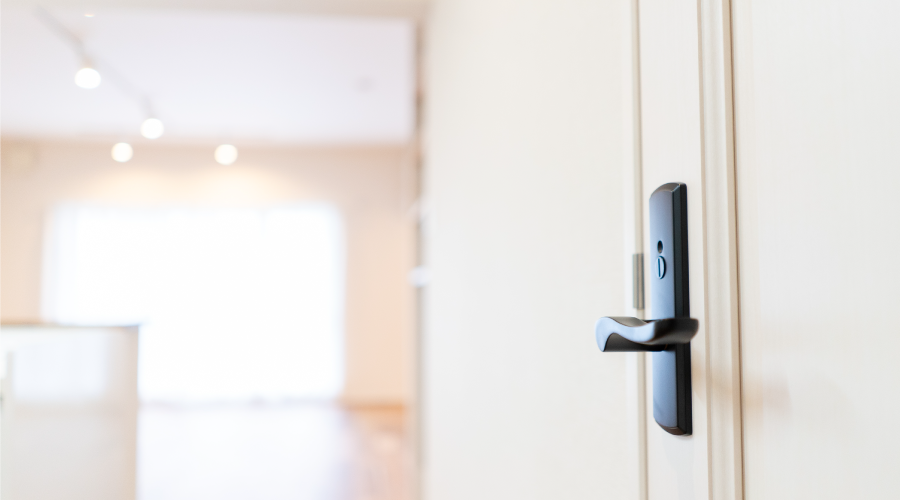The Doors to Success
Understanding today’s doors and door hardware products paves the way to savvy specification
Specifying doors and door hardware has always been a complex task, given the large number of doors in many facilities, the evolution of product offerings, and changes in codes and access guidelines. But the task of specifying the right door, locks, closers, exit devices and other access-control products has become even more challenging in recent years because of greater attention to safety and security.
One way to tackle such a task is to engage in up-front planning and a commitment to quality that will help ensure that the initial purchase meets facilities’ long-term performance. A closer look at the common types of doors and door hardware can help managers gain control of this immense but essential task.
Defining Function
Understanding the function of a particular door is the primary consideration in specifying hardware, so maintenance and engineering managers must answer basic questions early in the process: Is the door fire-rated? Is the main purpose to keep people out or in? How many people will use it each day?
Door hardware encompasses all components that hold a door in place and operate it: hinges, locks, handles, knobs, bolts, exit devices, door stops, holders, and accessories, such as weather stripping and padlocks.
Managers also must often consider specialty items, such as those for large glass doors or for doors used in hospitals, auditoriums, hotels and other buildings. Specialty items include: panic hardware; push and pull bars and plates; thresholds; kick plates; and door tracks and guides.
Locks
Commercial-quality locks have added features that provide facilities with heightened security, such as heavier-gauge metal, a longer throw on the latch, and additional locking functions.
Mortise locks, which are rectangular and embedded in the edge of a door, are stronger than other types and more expensive to purchase and install. They provide the highest level of security. The lock’s body is recessed into the door. Handles and cylinders, if required, are installed through the door into the lock body.
Cylindrical locks, which come in light-, medium-, and heavy-duty grades, are appropriate for many applications, though mortise locks tend to be more suitable when tight security is required. Cylindrical locksets are the most popular. The standard strike plate for these locks is the 497 ANSI, which is 47/8 inches long, but other sizes are available to meet specific facility needs.
Managers in commercial and institutional applications have a variety of different lock functions to consider for the application at hand, but four types are used most often:
Passage. Locks that address this function have no key or push button on either side. Instead, they consist of two blank handles, and both sides of the door are always unlocked. This type of lock sometimes is used on stairwell doors and other doors where the only requirement is to have the door latch behind the user but not lock so it can be opened at all times.
Entry. Locks that address this function require a key on one side and a push button on the other. When the button is depressed, the lock can be unlocked from the outside with a key. Turning the handle on the inside unlocks the door until either the button is depressed again or it is locked from the outside with a key. This lock is mostly used on doors that require some type of security, such as exterior and office doors.
Privacy. Locks that address this function have a push button on one side and an emergency release on the other. Such locks are made so they can be locked from the inside, but they can be opened from the outside with a coin or a screwdriver in case of emergency. This type of lock is used commonly on bathroom doors.
Storeroom. Locks for this function have a key on one side and a blank handle on the other side, with no key or button. The lock remains locked all the time and requires a key to open it. This lock is mostly used on storage and janitor’s closets and utility rooms.
Handles and Hinges
Lever handles are most commonly used in institutional and commercial applications to meet guidelines established under the ADA. This component is the most visible and touched portion of the assembly, so a good, lasting finish is important. Brass is probably used most often for decorative applications. Steel, however, offers both higher strength and lower cost. Many facilities are installing touch-sensitive bars, which can provide one-way, keyless access to a door that must remain locked.
The type of hinge used in a particular application depends on the door mount and function. For example, spring hinges use a spring as an automatic closer and are best used on doors that don’t receive heavy traffic. Swing-clear hinges are bent so a door can open fully, allowing a clear opening.
Among conventional hinges, five knuckles used to be standard, but many installations have moved to three-knuckle hinges. Spring hinges close a door automatically after it has been opened, like a door closer, but they have no sweep and latch control. The only adjustment is the speed with which the door will close.
The types of hinges most commonly used in commercial and institutional facilities are these:
- Butt hinges are used with wood and hollow metal doors. These hinges only use the pin housing, called the knuckle, when a door is closed. If security is required, managers can specify that the pin be non-removable.
- Surface hinges are used when it is not possible to mortise the door and jam.
- Invisible hinges are concealed in a mortise hole in the door and jam.
- Floor hinges are inserted into a mortise in the door head and bottom for a double-swinging door. This type of application might include a closer device.
- Gravity–type pivot hinges are used for applications such as café doors swinging in both directions.
- Pivot-type hinges are used primarily for cabinet doors.
- Electric hinges supply electric power continually between the door and jamb for alarm systems or electric locks. Electric hinges are mounted in the center, non-load-bearing hinge position for three-hinge doors.
On exterior out-swing doors, it is a good idea to have some kind of means of security so the hinge pin cannot be removed to gain entry. This precaution usually is addressed with a non-removable pin hinge.
Closers
Closers — hydraulic and pneumatic — control the closing of doors and reduce shock to doors and hardware. Hydraulic closers, common in commercial applications, contain an oil reservoir and cylinder with an adjustable nut that controls flow of oil into the cylinder to adjust the closing speed and the impact against the door frame when closing. Pneumatic closers have an adjusting nut to control the air flow and rate of closing.
Door closers are required on fire-rated doors so the door will close after someone has passed through it. Most closers have a sweep and latch adjustment. Sometimes, facilities need the door to close quickly and then slow down right before closing to avoid slamming. Other applications require the door to close slowly and then speed up at the very end to ensure it actually latches.
Closers control a door throughout its opening and closing swing. Electronic controls bring a different type of security to doors. One group of operators is designed for standard-duty applications on interior and exterior doors, providing free entry and exit to all types of commercial and institutional facilities, including assisted-living facilities, schools, universities, office buildings, convention centers and hotels.
Another group of door operators have 28 programmable control points, allowing adjustments for opening and closing forces, hold-open time, safety function, force to keep the door closed, and push-and-go features. When in a manual mode, the door must be opened slightly by hand. The operator then opens the door the rest of the way. Many of these operators offer lower energy use, which is attractive to managers.
Knowing the Codes
Building codes and facility access guidelines can have a tremendous impact on managers’ decisions on door hardware specification and installation. Hardware installation, particularly on fire doors and building exits, is governed by local and national codes.
Managers must be familiar with the Americans with Disabilities Act (ADA) and the National Fire Protection Association’s life safety code as they relate to door hardware. Fire codes and the ADA also guide managers on the placement of panic door hardware.
For example, some states require a mounting height of 30-44 inches. Others prohibit placing panic bars below 36 inches. Many jurisdictions require a 32-inch clear opening for wheelchairs, but in some applications, panic hardware can stick out and become an obstruction.
Also, some panic hardware isn’t allowed on a 3-foot door, but codes provide that anything mounted above 34 inches may extend 4 inches into the width of the door.
The bottom line is that when it comes to the actual installation of the hardware, it is essential to know and understand applicable codes.
|
Related Topics:











